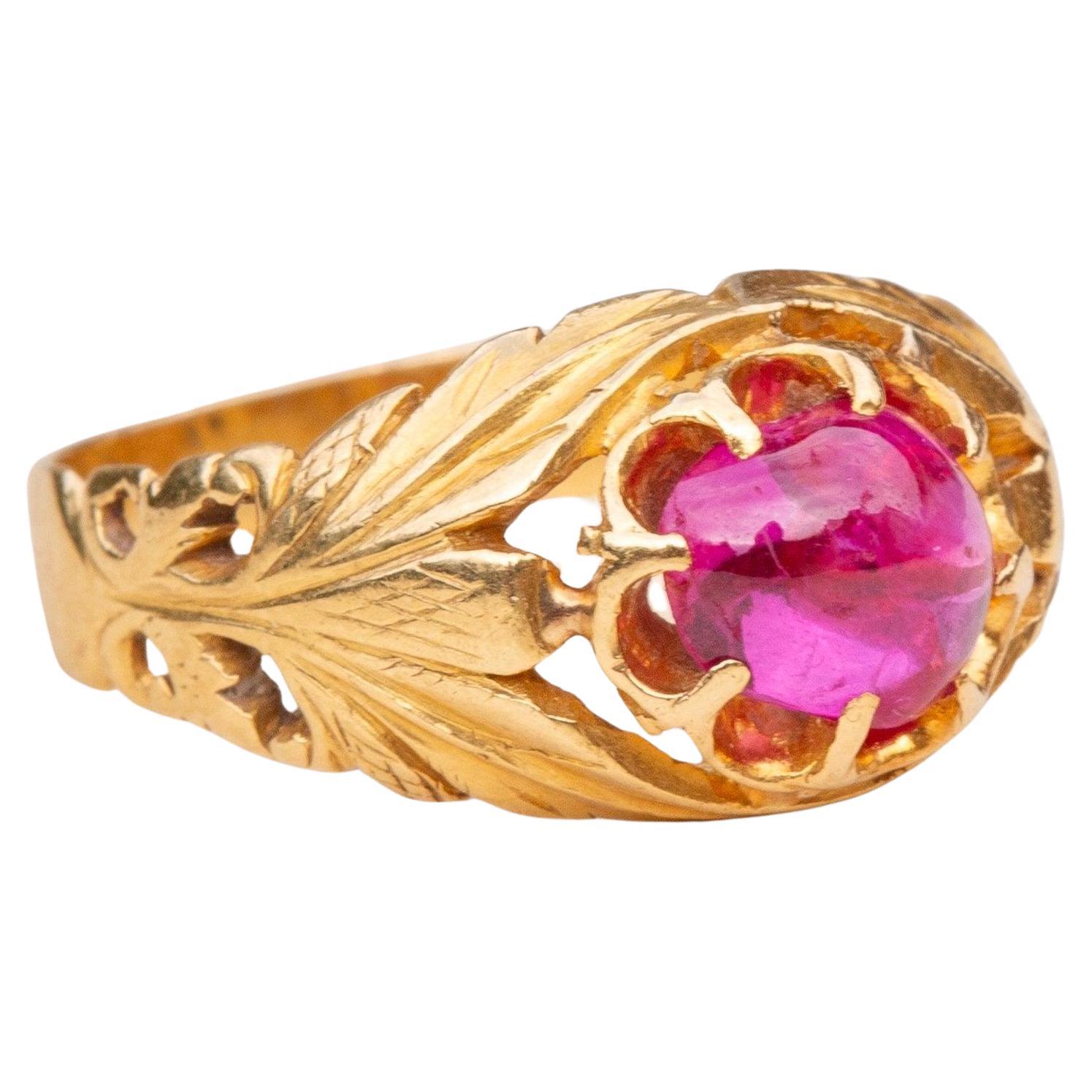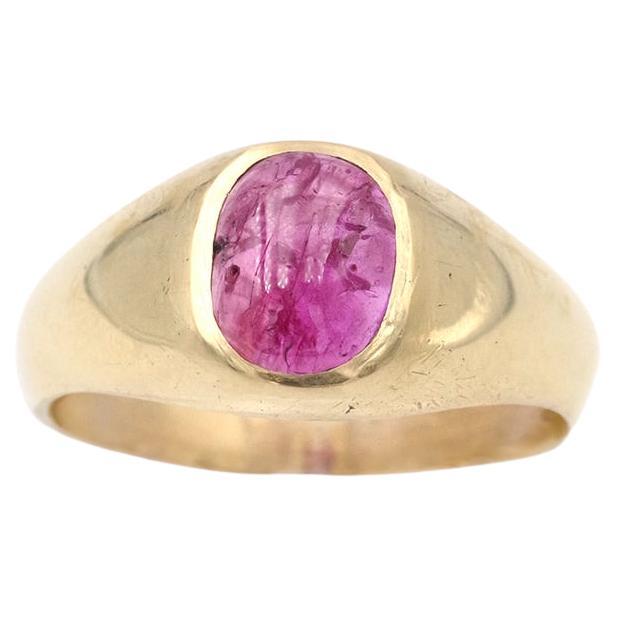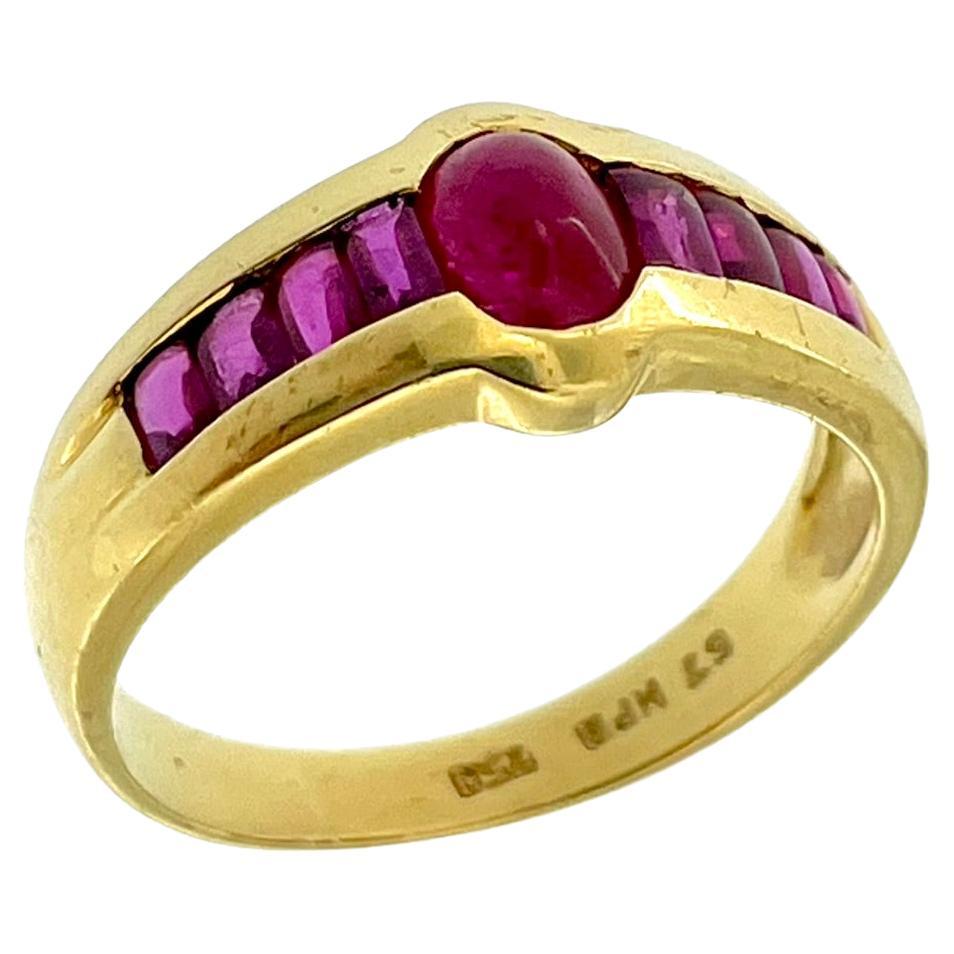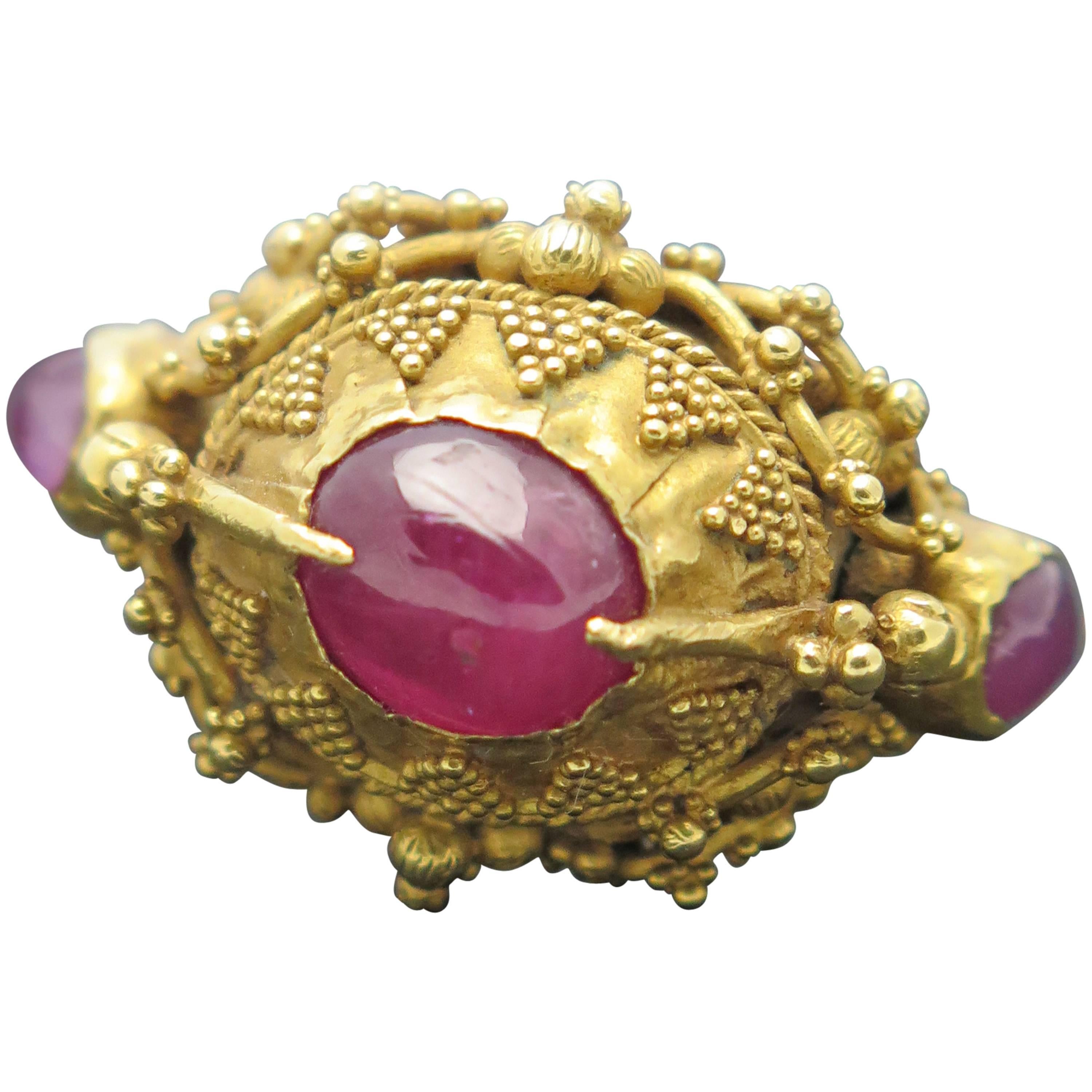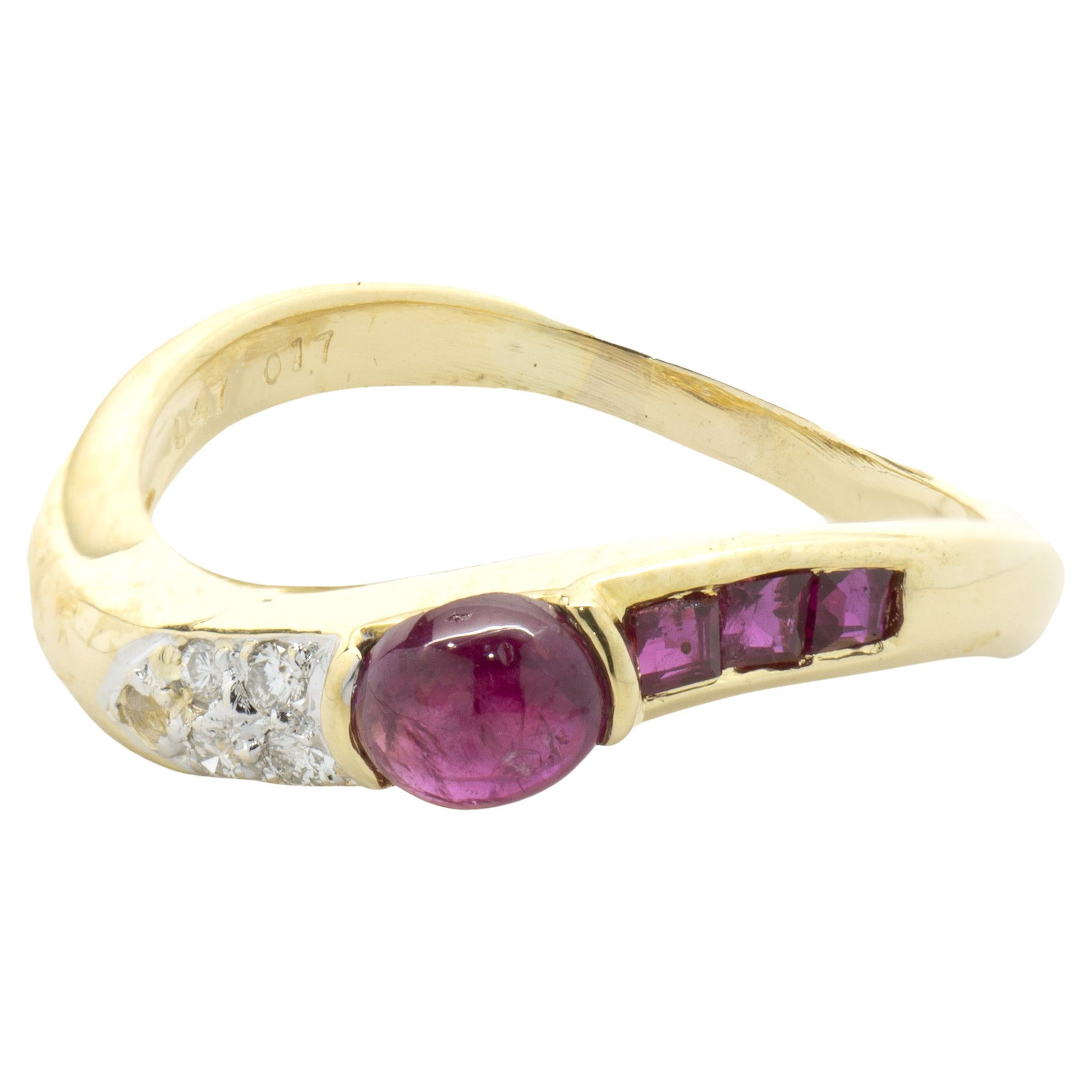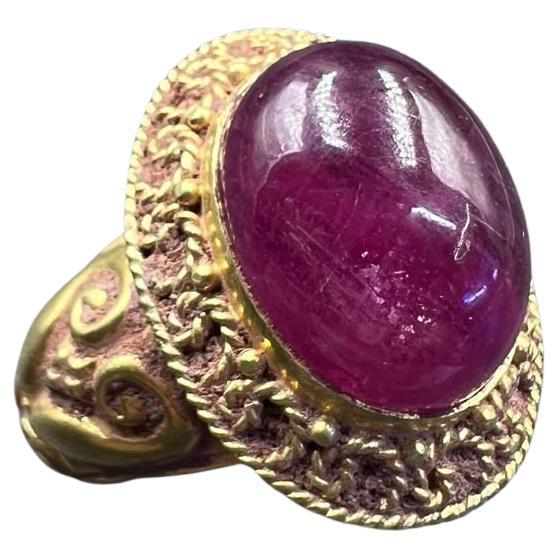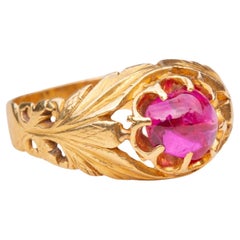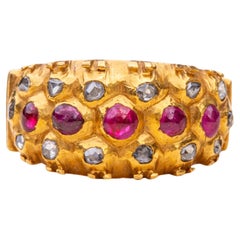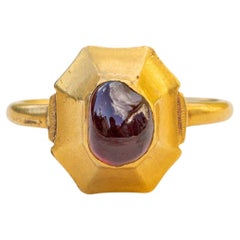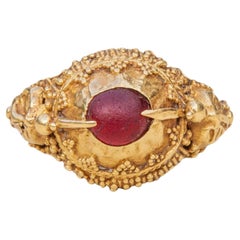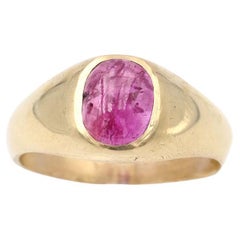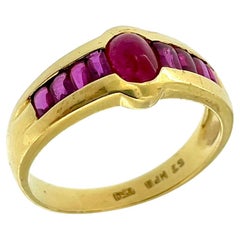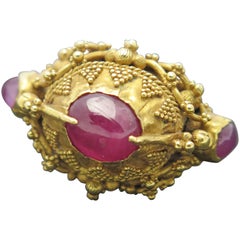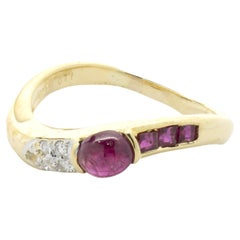Items Similar to Ancient Javanese Gold Ring with Ruby Cabochon Java Indonesian Antique Solitaire
Want more images or videos?
Request additional images or videos from the seller
1 of 20
Ancient Javanese Gold Ring with Ruby Cabochon Java Indonesian Antique Solitaire
$6,195.80
£4,500
€5,312.54
CA$8,521.97
A$9,478.87
CHF 4,972.60
MX$115,663.79
NOK 62,412.45
SEK 58,816.17
DKK 39,655.83
About the Item
A scarce early Javanese gold and ruby ring dating from the 7th-15th century Indonesian Classical period.
As expected with Javanese gem-set gold rings made in this period, the present ring is crafted high-karat gold and set with a polished cabochon. The ring has a circular bezel, holding a ruby of approximately 0.7cts. The ruby is of a pinkish red colour and features natural inclusions throughout. The protuberant, stirrup-shaped shoulders of the ring are designed to mimic the shape of water buffalo horns, a typical characteristic of Javanese rings.
One of the largest and most important islands in the Indonesian archipelago, Java has long been a great centre of art and civilisation. Gold finger rings are the most common form of jewellery found on ancient Java. Inventories of gold artefacts found in archaeological excavations reinforce the notion that rings were ubiquitous during this period. Not only was gold jewellery a significant symbol of wealth, status and power - but it was also used a currency in itself and functioned as standardised payment for numerous goods and services like salaries, fines and wedding banquets. In ancient Java, rings were also believed to have magical properties; predominantly the ability to bring good fortune and protection to the wearer. In fact, the literal meaning of the word ‘ring’ in Old Javanese translates to ‘guardian against enemy’.
Although corundum (sapphires and rubies) is not local to Java, they are often found on ancient Javanese rings and would have originally come from Sri Lanka, Myanmar or Central Asia. The stones on ancient gem-encrusted Javanese rings were not only chosen for their beauty and value, but also for their supposed astrological, magical and medicinal powers.
UK ring size J, US size 4.75
7.13g of high karat gold (19K/20K gold)
Despite its impressive age, the ring is in wearable condition. The stone is securely set; however under loupe magnification there is a small chip to one of the corners of the ruby.
Stone measures 7mm x 6mm. Band measures 2mm across at the back, and about 10mm at the front. Stone tested as corundum (ruby).
- Ring Size:4.75 US, Resizable
- Metal:
- Stone:
- Stone Cut:
- Weight:7.13 g
- Place of Origin:Java
- Period:
- Date of Manufacture:1100
- Condition:Wear consistent with age and use.
- Seller Location:London, GB
- Reference Number:1stDibs: LU2845222127542
Resizing is available.
About the Seller
5.0
Vetted Professional Seller
Every seller passes strict standards for authenticity and reliability
Established in 2019
1stDibs seller since 2022
46 sales on 1stDibs
- ShippingRetrieving quote...Shipping from: London, United Kingdom
- Return Policy
Authenticity Guarantee
In the unlikely event there’s an issue with an item’s authenticity, contact us within 1 year for a full refund. DetailsMoney-Back Guarantee
If your item is not as described, is damaged in transit, or does not arrive, contact us within 7 days for a full refund. Details24-Hour Cancellation
You have a 24-hour grace period in which to reconsider your purchase, with no questions asked.Vetted Professional Sellers
Our world-class sellers must adhere to strict standards for service and quality, maintaining the integrity of our listings.Price-Match Guarantee
If you find that a seller listed the same item for a lower price elsewhere, we’ll match it.Trusted Global Delivery
Our best-in-class carrier network provides specialized shipping options worldwide, including custom delivery.More From This Seller
View AllAntique Indian Gold Ruby Cabochon Ring Mughal Period
Located in London, GB
A scarce late Mughal period Indian gold and ruby ring dating from the mid-19th century.
The cabochon cut ruby is belcher set in an open-backed mount and weighs approximately 1ct. Th...
Category
Antique Mid-19th Century Indian Late Victorian Engagement Rings
Materials
Ruby, Gold, 22k Gold
Royal 19th Century Siam Diamond and Ruby Ring
Located in London, GB
A rare 19th century princely gold cluster ring made in Siam (Thailand), circa 1860.This gorgeous ruby and diamond ring was intricately crafted in high-karat gold, by the goldsmiths of the royal Siam court in the 19th century.
It is a fine example of the lavish adornment worn by participants in royal and aristocratic life-cycle ceremonies in the courts of Bangkok. Aside from ceremonial use, they were also occasionally given as gifts to important visitors or other aristocratic families.
There was a huge expansion in the number of royals in 19th century Siam which stemmed from Kings Mongkut (Rama IV) and Chulalongkorn (Rama V) being highly polygamous. They had a joint total of 124 wives and 159 royal children, each requiring their own ceremonial regalia and princely jewels. As a result, Bangkok became home to some incredibly skilled goldsmiths in this period and the sheer number of jewellery required has meant that today princely jewels like this one can very occasionally be found in the open market, particularly in Europe following the relocation of the Thai royal family to Switzerland and France in the 1930’s and 1940’s.
The ring features a row of cabochon rubies horizontally aligned, surrounded by a sea of rose cut diamonds. All of the stones are in rubover settings within a web of hexagonal honeycomb frames. The band is decorated with pierced and deeply chased scrollwork motifs, typical of Siam jewellery...
Category
Antique Mid-19th Century Thai Band Rings
Materials
Diamond, Ruby, 22k Gold
Scarce Medieval Gold Garnet Ring Antique 13th Century Talisman Signet Ring
Located in London, GB
An exceptionally rare late 13th century Medieval period gold ring, made either France or England, circa 1280!
This Medieval high-karat gold ring is set with a large 11ct irregular-s...
Category
Antique 15th Century and Earlier European Engagement Rings
Materials
Garnet, 22k Gold
Antique Gold Indonesian Bali Garnet Ring 19th Century Hummingbird Gold Ring
Located in London, GB
A scarce late 19th century gold ‘priest’s ring’ from the island of Bali, Indonesia.
The ring is a fantastic example of the southern Balinese style, where ...
Category
Antique Late 19th Century Engagement Rings
Materials
Gold
Scarce Antique Catalan 18th Century Gold Foiled Rose Cut Perpignan Garnet Ring
Located in London, GB
This antique conversion piece started life as a regional ‘Croix Badine’ (Badine cross) dating to the late 18th century, the most emblematic jewel of the Catalan part of the Languedoc-Roussillon region. The badine cross is a regional cross mounted with rose cut and foiled Perpignan garnets...
Category
Antique Late 18th Century French Georgian Solitaire Rings
Materials
Garnet, Gold
Antique Thai Siam 19th Century Gold Princely Gem-Set Cluster Ring Ruby Emerald
Located in London, GB
A rare late 19th century gem-set princely gold cluster ring made in Siam (Thailand).
This gorgeous and colourful gem-set cluster ring is intricately crafted in high-karat gold, by the goldsmiths of the Siam court in the 19th century. The centre features a rose cut diamond in a rubber gold setting which is riveted to the body of the ring which is visible from the underside, a feature typical of 18th and 19th century Siam rings . It is surrounded by a halo of rubies, garnets and diamonds, with emeralds on the shoulders. The thick gold band features pierced scrollwork motifs and is stamped with a French gold import mark from when it was later brought into the country.
This ring is a fine example of the lavish adornment worn by participants in royal and aristocratic life-cycle ceremonies in the courts of Bangkok. Aside from ceremonial use, they were also occasionally given as gifts to important visitors or other aristocratic families. Examples of these lavish jewels being worn can be seen on old photos and paintings of life-cycle ceremonies such as the Royal Tonsure Ceremony, also known as ‘the cutting of the top-knot’ ceremony, which marked the transition into adulthood for all of the (many!) sons and daughters of the Siam royal family. The huge expansion in the number of royals in 19th century Siam stemmed from Kings Mongkut (Rama IV) and Chulalongkorn (Rama V...
Category
Antique 19th Century Thai Cluster Rings
Materials
Diamond, Ruby, Emerald, Gold
You May Also Like
Heavy solid gold ruby cabochon band ring in 18k, Retro ruby ring, man ring
Located in PARIS, FR
Solid ruby band ring in 18 karat. Large ring centered with a natural ruby cabochon weighing 1.86 carats, suitable for men or women. The ring is solid gold, the ruby has a deep pink c...
Category
Vintage 1950s Belgian Retro Signet Rings
Materials
Ruby, Gold, 18k Gold
Vintage 18kt Yellow Gold Ruby Ring
Located in Esch sur Alzette, Esch-sur-Alzette
The "Vintage 18kt Yellow Gold Ruby Ring" is a classic and elegant piece of jewelry that combines the timeless beauty of yellow gold with the rich, vibra...
Category
Mid-20th Century French Post-War Band Rings
Materials
Ruby, 18k Gold, Yellow Gold
Balinese Ruby Gold Ring
Located in Austin, TX
Finely worked in high karat gold (22k+) and featuring three rough cut ruby cabochons ranging form light pink to purplish pink, typical of rubies from In...
Category
Mid-20th Century Indonesian More Rings
Materials
Ruby, 22k Gold, Yellow Gold, Gold
18 Karat Yellow Gold Cabochon Ruby and Diamond Ring
Located in Scottsdale, AZ
Designer: custom design
Material: 18K yellow gold
Diamond: 5 round brilliant cut = 0.06cttw
Color: H
Clarity: SI1
Ruby: cabochon and princess cut = 0.64cttw
Dimensions: ring top meas...
Category
21st Century and Contemporary Fashion Rings
Materials
Diamond, Ruby, 18k Gold, Yellow Gold
Bochic “Orient Antic” Curated Antique Ring From Burma 18k Solid Gold & Ruby
By Bochic
Located in New York, NY
Bochic Curated Antique Ring From Burma 18k Solid Gold & Ruby
This is the kind of ring you see in a Museum
South East Asian Antique Agate Gem Old Burmese Pyu Pagan Gold Ring
Natura...
Category
Antique Late 19th Century Burmese Retro Dome Rings
Materials
Ruby, Gold, 18k Gold
Vintage 14K Gold Ruby Ring
Located in Flushing, NY
Vintage 14K Gold Ruby Ring
Marked:
14K
Approximate Dimensions:
7.5 (Ring Size)
14.95 mm x 13.46 mm x 8.95 mm (Star Sapphire)
7.9 grams in weight.
** All dimensions listed above ar...
Category
20th Century Engagement Rings
Materials
Ruby, Gold, 14k Gold
More Ways To Browse
20k Wedding Ring
Antique Sapphire Solitaire Ring
Indonesian Wedding
Indonesian Antique Jewelry
Antique Ruby Wedding Ring
Antique Gold Signet Ring J
Rare Antique Cameo Rings
Renaissance Intaglio
Mens Sapphire Signet Ring
Vintage Art Deco Mens Ring
Antique Signet Ring Men
Masonic Signet
Mens Gold Cross Ring
Antique 18 Karat Gold Signet Ring
B Signet Ring
Intaglio Lion
Large Intaglio Ring
Men Lion Ring
